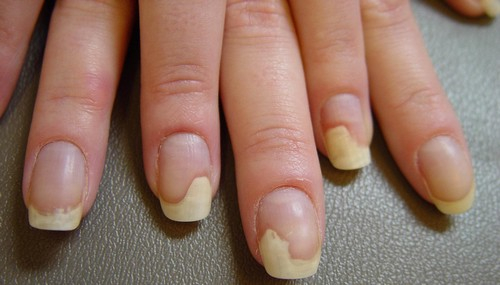Nails are necessary not only to provide a protective barrier to the fingers, but are also an important element of human aesthetic perception. Along with the face, neck and hands, nails are one of the few areas of the body that are constantly in the spotlight.
Thus, their appearance is of great cosmetic importance. With the advent of acrylic and gel manicures, dermatologists are increasingly faced with the complications that arise from the behavior of these aesthetic procedures. On estet-portal.com read about the dangers of applying a nail coating, as well as how to avoid these consequences of a manicure.
The main risks: why a manicure can be dangerous
In the process of manicure, any person may face dangers, including:
• procedure-related infections;
• inadequately sterilized instruments;
• micro- and macro-injuries that may occur due to the removal of the cuticle, which increases the risk of infection;
• nail coating materials containing certain chemicals that irritate the skin around the nail;
• chemicals, especially acrylates and formaldehyde, which can lead to contact dermatitis and chronic paronychia;
• Primers and nail polish removers, which are mostly solvents, can dry out nails and make them brittle.
Thus, the use of even the highest quality materials can be fraught with serious consequences that will spoil the aesthetic appearance of nails.
Read the most relevant articles in Telegram!
The main changes that may occur after a manicure
Among the consequences of a manicure, the most common is a change in the color of the nail plate. Aggressive varnishes, especially red and black, can change the color of the nail for more than two weeks. This phenomenon should not be frightened, but it can be countered by applying a base coat of clear varnish.
Traumatic onycholysis is a common manicure complication resulting from traumatic separation of the nail plate from the nail bed. Most often occurs in patients with acrylic coating, since the fixation of the varnish to the surface of the nail is higher than the fixation of the nail plate to the nail bed.

Traumatic onycholysis
Pseudo-psoriatic nails occur after acrylic manicure is removed. As with psoriasis of the nails, this phenomenon is accompanied by onycholysis and hyperkeratosis, as a result of which difficulties in the differential diagnosis of these lesions can often arise.
The process of binding varnish to the nail and then removing it from the nail plate can lead to degranulation of keratin. Clinically, this is manifested by the appearance of white stripes and spots on the nail plate. It is currently not known whether the type of lacquer influences this side effect, however, experience has shown that frequent removal of lacquer by mechanical means is more conducive to keratin degranulation.
Mycobacterial infections are caused by infection through the use of pedicure baths. Clinically, they are manifested by erythematous spots and papules that appear a couple of weeks after a pedicure on the distal parts of the lower extremities.
There is a high risk of contact dermatitis in response to exposure to chemical agents used for manicure.
Peripheral neuropathy is a rare complication of acrylic manicure resulting from the toxic effects of this substance.
Despite the fact that gel polish is positioned as easy to remove, very often it is firmly fixed to the nail. As a result of the removal of such a manicure, thinning and traumatization of the nail plate may occur. Also, the varnish blocks the oxygenation of the nail, as a result of which it can change its relief and color.
Psoriasis of the nails: clinic, diagnosis, treatment
Recommendations for the prevention of manicure complications
To minimize the likelihood of side effects when using gel polish, you must:
• periodically take breaks between coats, at least one to two weeks;
• Maintain nail hydration. This will minimize their fragility and prevent chipping;
• to do a manicure and remove the coating in the salon;
• apply castor oil masks, as well as other means to restore nails.
Thus, careful attitude to the nails on the part of the patient allows you to keep them healthy. However, it is important for the dermatologist to be aware of the complications that can occur when using varnish, so as not to be mistaken in the differential diagnosis with other serious nail lesions.
Read also: Nail color helps to diagnose many diseases in a timely manner







Add a comment